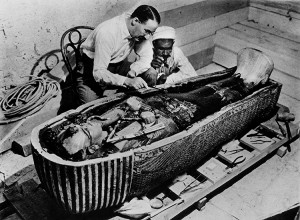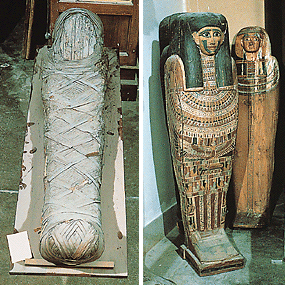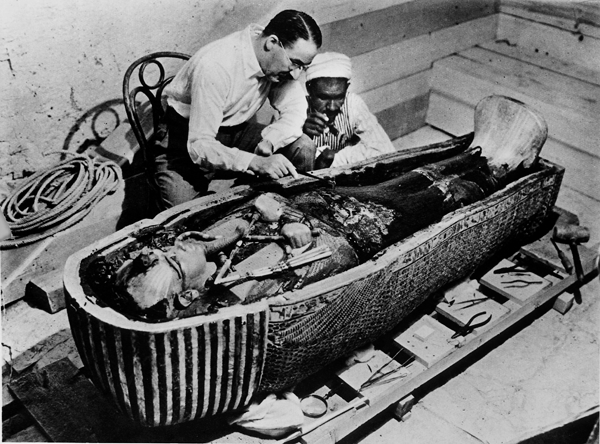King Tut’s Extraterrestrial Dagger
Thursday, June 2nd, 2016June 2, 2016
A new study conducted by Italian and Egyptian scientists found that an iron-bladed dagger from the tomb of Tutankhamun, ancient Egypt’s most famous pharaoh (king), had an extraterrestrial origin. An analysis of the metal blade found that the iron most likely came from a meteorite. This rare source of iron was highly prized by the ancient Egyptians. A special hieroglyphic describes such iron as “metal from heaven.”

Archaeologist Howard Carter works with Tutankhamun’s mummy in 1922. Among the many riches from Tut’s tomb was a rare iron-bladed dagger probably made from the metal of a meteorite.
CREDIT: © Time & Life Pictures/Getty Images
British archaeologist Howard Carter discovered the long-hidden tomb of Tutankhamun (often called “King Tut”) in 1922. The discovery was a great sensation. King Tut served as ruler of Egypt from about 1332 B.C. until his death around 1322 B.C. The tomb had not been opened since ancient times. It still contained many of its treasures. It is the only tomb of an ancient Egyptian king to be discovered almost completely undamaged. Tut’s four-room tomb contained more than 5,000 objects, including many beautiful carved and gold-covered items. The dagger, found nestled in the wrappings of the pharaoh’s mummy, was finely crafted with a gold and crystal handle and a richly decorated sheath. But scientists found the blade of the dagger most intriguing. It was made of iron, a metal that was virtually unknown in ancient Egypt.
Although people in the ancient world worked copper, bronze, and gold beginning about 4,000 B.C., iron working developed much later. Historians generally mark the beginning of the Iron Age at 1,200 B.C., long after Tutankhamun’s death. Iron deposits are also uncommon in and around Egypt, and iron tools or weapons from ancient Egypt are very rare. Scholars have long suspected that the iron used to fashion precious objects found in ancient Egyptian tombs may have come from meteorites. Scholars believe ancient Egyptians might have regarded meteorites as gifts from the gods suitable only for kings. However, this theory has been difficult to prove.
In the latest study, scientists analyzed the dagger using a technique called x-ray fluorescence spectrometry to determine the composition of the blade. Fluorescence is a process by which substances give off light or another form of electromagnetic radiation when they absorb energy. Using this technique, scientists aimed a beam of high energy x-rays at the blade. By measuring the radiation emitted, they determined the types and abundances of various elements that made up the blade. They found that the blade was composed of iron, nickel, and cobalt. The relative amounts of these elements in the dagger were remarkably similar to those found in iron-rich meteorites. They then compared the chemical makeup of the dagger to meteorite samples obtained from sites within about 1,250 miles (2,000 kilometers) of Cairo, Egypt’s capital. One particular sample, known as the Kharga meteorite, had a composition of iron, nickel, and cobalt nearly identical to Tut’s dagger, strongly supporting its extraterrestrial origin.




